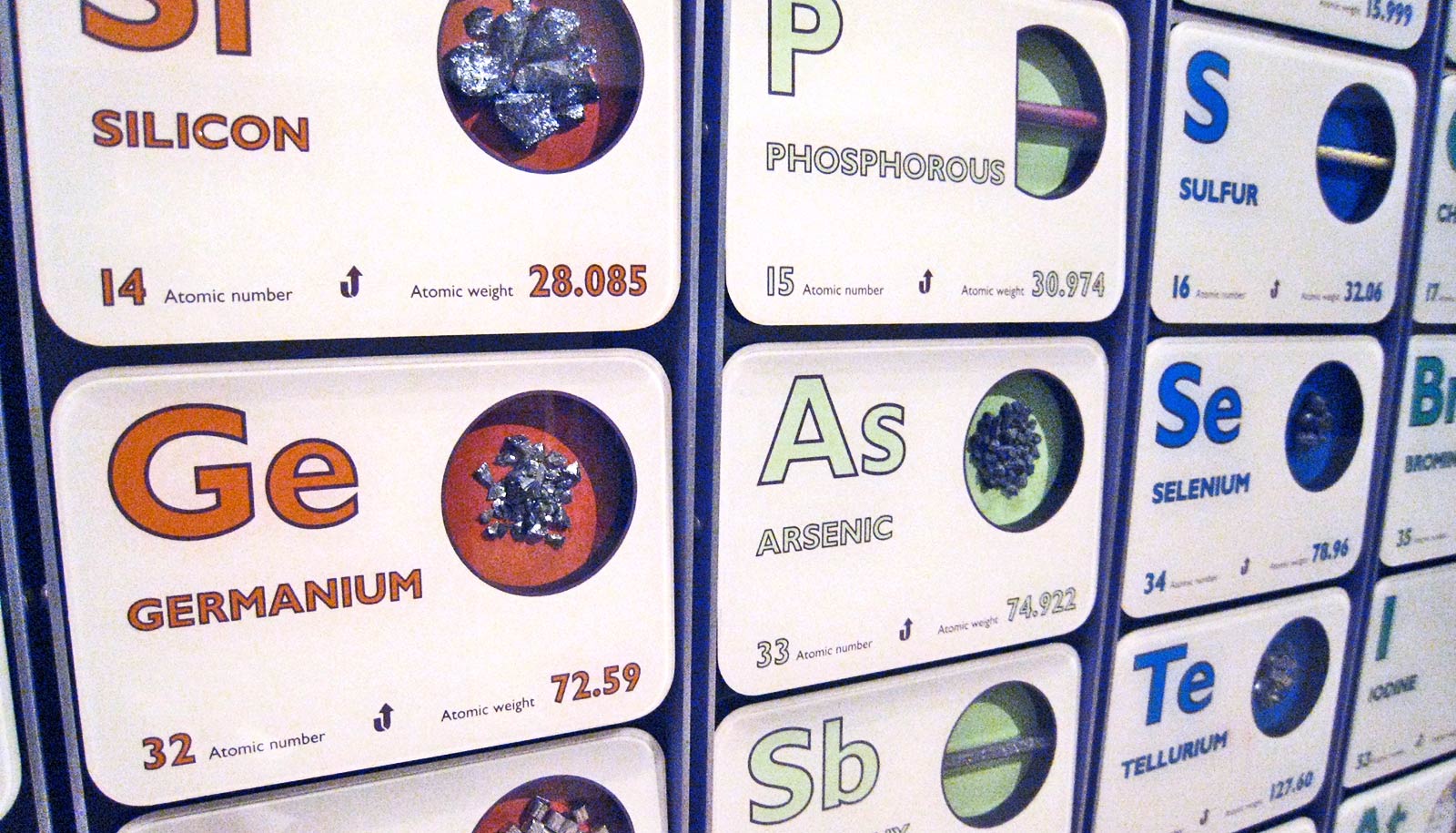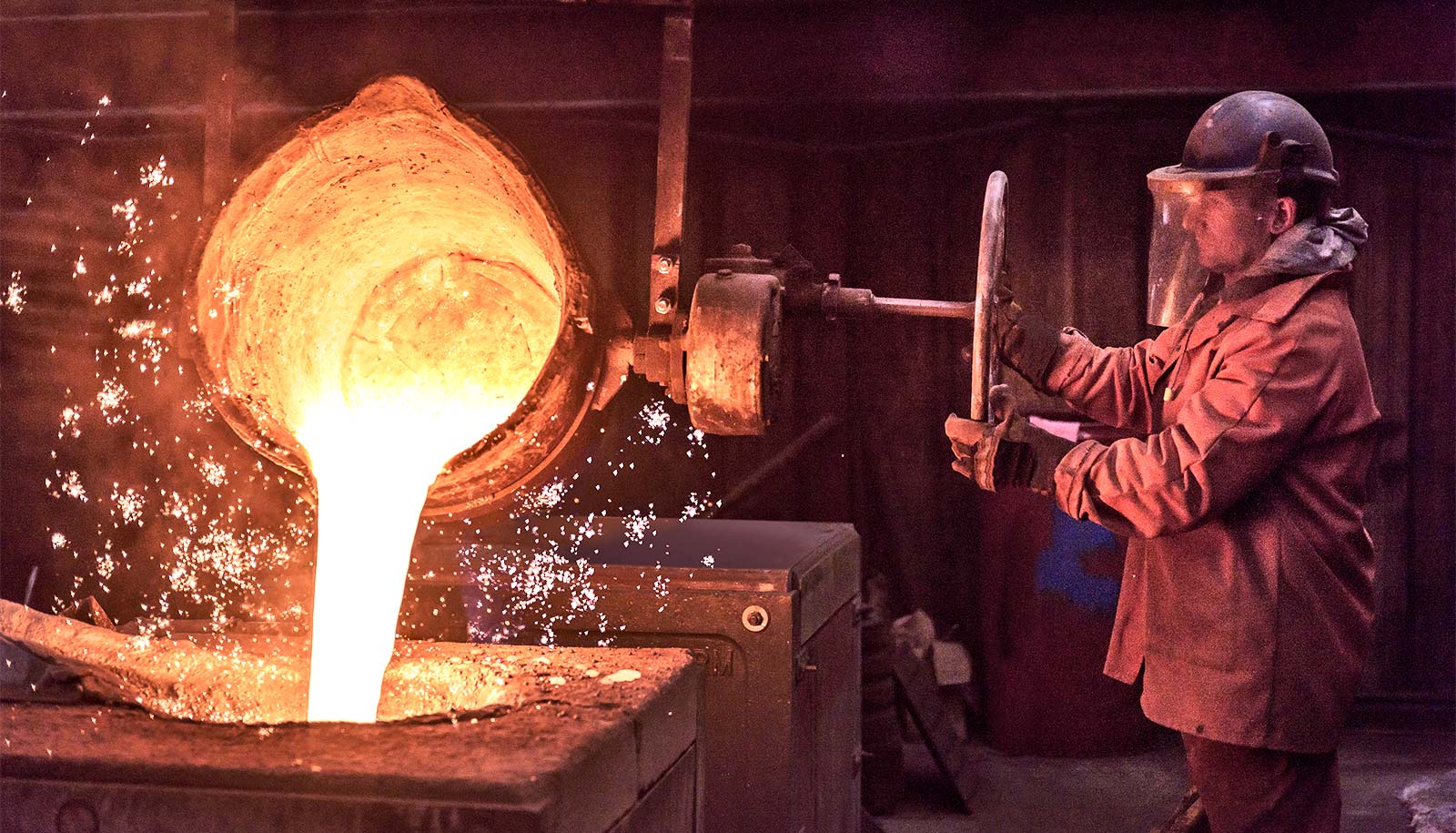2019 marks the 150th anniversary of the periodic table.
Chemical elements make up everything around us. Reading this on a cell phone? Your phone contains at least 30 different naturally-occurring elements, including lithium. Or maybe you’re drinking seltzer—a compound of two elements (carbon and oxygen in the form of carbon dioxide) dissolved in another two elements (hydrogen and oxygen in the form of water).
Developed by Russian scientist Dmitri Mendeleev in 1869 (with contributions from many other scientists before and after Mendeleev), the familiar poster on chemistry classroom walls started out as a novel way to sort and categorize the elements.
In Mendeleev’s periodic table, he organized the 63 elements known in 1869 by their atomic weight, grouping those with similar properties. He also had the foresight to leave open spots on the table to anticipate elements that had not yet been discovered.
Mendeleev was onto something. Over the ensuing century and a half, scientists have added many new elements into the table’s gaps, bringing us to 118 elements today. As the American Chemical Society noted earlier this year, “Changes to the periodic table continue to this day and will likely keep surprising us in the future. As recently as 2016, scientists officially filled the four final gaps in period 7—elements 113, 115, 117, and 118.” Like many elements, two of the newest are named after places where research to create the elements took place: moscovium and tennessine.
In honor of the period table’s 150th anniversary, a group of chemists name their favorite elements and explain why they love them. From lithium (#3) to gallium (#31), here are their picks:
Lithium
Alexej Jerschow, professor of chemistry:
“Lithium is by far my most favorite element these days. It is one of the lightest elements, and it has been incredibly transformative. All our cell phones and computers have lithium-ion rechargeable batteries, and the Nobel Prize in Chemistry this year was awarded for the development of lithium-ion batteries.
“In my lab we are intimately familiar with the element, as we develop techniques that allow us to peek inside batteries to determine whether they are functioning well and to obtain clues for how to improve batteries, extend their lifetimes, and for keeping them safe.”
Carbon
Dirk Trauner, professor of chemistry:
“I like carbon because the rules with which carbon atoms connect are so simple, yet the structures that can be created with them (and a few lighter and heavier supporting actors) are so diverse. After one lecture, students can propose molecules that have never been made or even thought of before but are most likely stable. You can bet the farm (and your career) on carbon!”
Nitrogen
Ned Seeman, professor of chemistry:
“Nitrogen. It is the element that is inherent to the two semantophoretic molecules [which carry information] of biology, nucleic acids, and proteins. Without nitrogen, biology is largely just sugar and fat.”
Silicon
Keith Woerpel, professor of medicinal chemistry:
“Silicon. It’s in almost everything: rocks, sand, computers, those little packets you find inside shoes. It is the element most like carbon, but it is so unlike carbon that it leads to unexpected chemical behavior that can be really useful. And just for the record: no, I don’t think there could be life, as we know it, based on silicon instead of carbon.”
Calcium
Marc Walters, associate professor of chemistry:
“My current favorite element is calcium. It is the stuff of our geosphere as a component in limestone and gypsum minerals and our biosphere in the form of bones, teeth, seashells, and even egg shells. It gives us backbone and structure. But not just us… As a component of portland cement and clad gypsum (drywall), it serves to fashion shells and shelter for people, too.
“It is a component of chalk which, up until the advent of dry erase markers, has served to enhance the structure to our ideas and expression spoken or wordlessly sketched upon a blank slate.”
Iron
Andy Hamilton, professor of chemistry and president of NYU:
“It is usual for most organic chemists to say that their favorite element is carbon, due to its role as the fundamental building block of life. But for me, it is the element iron (Fe) that holds most fascination. Iron is an element that, even in a biological setting, can access multiple oxidation states to carry out a range of critical functions.
“In its Fe2+ state, it can be found (surrounded by my favorite molecule—the porphyrin ring) in hemoglobin. This remarkable combination of Fe2+ and porphyrin gives blood its bright red color and also the ability of the Fe2+ to bind to oxygen (O2) and transport it around the body. The dangerous effects of carbon monoxide (CO) come from its ability to bind even more tightly to the Fe2+ in hemoglobin and prevent access to the life-giving oxygen molecule.
“Iron cycles between its Fe2+ and Fe3+ states in the cytochrome proteins, one of whose critical roles in life is to transport electrons around the cell. The deadly poison cyanide (CN-) binds to the Fe2+ in cytochrome, just like the O2 or CO does in hemoglobin, blocking that cycle and completely destroying the pathways of energy management in living cells.
“Lastly, iron accesses Fe4+ and Fe5+ states in the oxidizing enzyme cytochrome P450. This protein functions in the liver as nature’s bleach, often cleaning up all the unwanted messes that find themselves inside living organisms, including us!”
Copper
James Canary, professor and chair of the chemistry department:
“I am a fan of the element copper. Not only is it pretty when shiny, but it also displays amazingly diverse chemistry. It was discovered 11,000 years ago and is named after Cyprus. The Copper Age (Chalcolithic) in the Middle East is one of my favorite periods in history. It is an essential element for all life on the Earth. In its natural, metallic form, it is highly conductive and malleable, making it an ideal material for wires.
“In our research, we have found that it can cause a molecule that has a handedness like a rubber glove to turn itself inside out, resulting in the opposite handedness. Just like when you turn your left hand rubber glove insight out and it then fits your right hand, so can we do that with molecules.
“If the element loses one electron, it takes on a single positive charge, forming copper(I). Colorless copper(I) is a key player in living organisms for capturing, storing, and transporting oxygen in the cell. In human blood, iron plays this role, but copper(I) is very common in such a role among many organisms. Copper(I) is also used in organic chemistry for some reactions that are amazing in terms of what they do and their efficiency.
“If copper metal loses two electrons, it is left with two positive charges for each copper atom, copper(II). Compounds of copper(II) are typically blue in color. It loves to be dissolved in water and reactions involving attachment/dissociation to/from copper(II) can be very fast. Copper(III) is also known, but it is very reactive and not easy to observe.
“One of the amazing things to me is that copper(0), copper(I), and copper(II) are so different from one another that they seem like different elements. Everything about them is different—their appearance, their stability, and their reactivity.”
Gallium
Mike Ward, professor of chemistry:
“My favorite element has to be gallium—an atomic number of 31, a prime, surrounded by aluminum, germanium, indium, and zinc in the periodic table, and more rare than gold. It was predicted in 1871 by none other than Dmitri Mendeleev, who named it “eka-aluminium.” It was then discovered in 1875 by Paul Emile Lecoq de Boisbaudran, who named it after “gallia,” Latin for Gaul, otherwise known as France, his native country.
“Why is gallium so interesting? It melts near 30°C (86°F), slightly above room temperature. This property was key to a cheap parlor trick, wherein gallium forged into spoons for tea service would surprise by melting when used! Hence its appearance on the cover of the book The Disappearing Spoon: And Other True Tales of Madness, Love, and the History of the World from the Periodic Table of the Elements (Little Brown, 2010) by Sam Kean. Yet gallium is not simply a playful object—it is superior in many ways to silicon when used in electronics applications.”
Source: NYU



